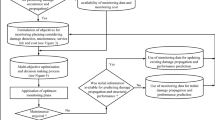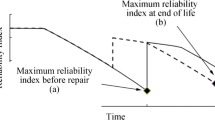Abstract
Effective and efficient service life management is essential for a deteriorating structure to ensure its structural safety and extend its service life. The difficulties encountered in the service life management are due to the uncertainties associated with detecting and identifying structural damages, and assessing and predicting the structural performance. To reduce these uncertainties, continuous long-term structural health monitoring (SHM) can be employed. However, a rational and practical SHM planning is required to simultaneously maximize the accuracy, efficiency, and cost-effectiveness in service life management. This paper proposes a probabilistic optimum SHM planning based on five objectives to be simultaneously optimized: minimizing the expected damage detection delay, minimizing the expected maintenance delay, maximizing the damage detection time-based reliability index, maximizing the expected service life extension, and minimizing the expected life-cycle cost. The formulations of the five objectives are based on the probabilistic fatigue damage assessment. The monitoring plannings associated with both a single- and a multi-objective probabilistic optimization process (MOPOP) are investigated. For efficient decision making in identifying the essential objectives and selecting a well-balanced solution among the Pareto optimal solutions, the degree of conflict among objectives and objective weights are estimated. The novel approach proposed in this paper accounts for the interdependencies among the five objectives considered and demonstrates the role of the optimum SHM planning in service life management of deteriorating structures. The proposed MOPOP SHM planning is applied to the hull structure of a ship subjected to fatigue.











Similar content being viewed by others
Abbreviations
- β :
-
Damage detection time-based reliability index
- δ :
-
Degree of conflict between ΩR and ΩI
- δ norm :
-
Normalized degree of conflict between ΩR and ΩI
- a 0 :
-
Initial crack size
- a crt :
-
Critical crack size resulting in structural failure
- a ma :
-
Critical crack size requiring maintenance action
- C fail :
-
Expected failure cost
- C lcc :
-
Expected life-cycle cost
- C lss :
-
Expected monetary loss due to the structural failure
- C ma :
-
In-depth inspection and maintenance cost
- C mon :
-
Monitoring cost
- E(t del_d ) :
-
Expected damage detection delay
- E(t del_m ) :
-
Expected maintenance delay
- f 1 :
-
Minimizing the expected damage detection delay
- f 2 :
-
Minimizing the expected maintenance delay
- f 3 :
-
Maximizing the damage detection time-based reliability index
- f 4 :
-
Maximizing the expected total service life extension
- f 5 :
-
Minimizing the expected life-cycle cost
- N mnt :
-
Number of available maintenance types
- N mon :
-
Number of monitorings
- t del_d :
-
Damage detection delay
- t del_m :
-
Maintenance delay
- t ex,i :
-
Service life extension induced by the maintenance followed by the ith monitoring
- t exlife :
-
Total service life extension
- t ins,i :
-
ith inspection time
- t life,i :
-
Extended service life after the ith monitoring
- t mar :
-
Time interval between the damage occurrence time and the time associated with the critical state
- t md :
-
Monitoring duration
- t ms :
-
Monitoring starting time
- w i :
-
Weight of the ith objective
- Ω I :
-
Initial objective set
- Ω R :
-
Reduced objective set
- Ф frn :
-
Pareto front
- Ф sol :
-
Pareto optimal solution set
References
Akpan UO, Koko TS, Ayyub B, Dunbar TE (2002) Risk assessment of aging ship hull structures in the presence of corrosion and fatigue. Mar Struct Elsevier 15(3):211–231
Arora JS (2012) Introduction to optimum design, 3rd edn. Elsevier, UK
Brockhoff D, Zitzler E (2006) Dimensionality reduction in multiobjective optimization with (partial) dominance structure preservation: Generalized minimum objective subset problems. TIK Report 247, ETH Zurich, Switzerland
Brockhoff D, Zitzler E (2009) Objective reduction in evolutionary multiobjective optimization: theory and applications. Evol Comput MIT Press 17(2):135–166
Chmielewski DJ, Palmer T, Manousiouthakis V (2002) On the theory of optimal sensor placement. AICHE J 48(5):1001–1012
Chong KP, Carino NJ, Washer G (2003) Health monitoring of civil infrastructures. Smart Mater Struct Institute of Physics Publishing 12(3):483–493
Deng H, Yeh C-H, Willis RJ (2000) Inter-company comparison using modified TOPSIS with objective weights. Comput Oper Res Pergamon 27(10):963–973
Diakoulaki D, Mavrotas G, Papayannakis L (1995) Determining objective weights in multiple criteria problems: the critic method. Comput Oper Res Pergamon 22(7):763–770
Farhey DN (2006) Instrumentation system performance for long-term bridge health monitoring. Struct Health Monit 5(2):143–153 SAGE
Fisher JW, Kulak GL, Smith IF (1998) A fatigue primer for structural engineers. National Steel Bridge Alliance, Chicago
Frangopol DM, Messervey TB (2011) Effect of monitoring on reliability of structures. In: Bakht B, Muſti AA, Wegner LD (eds) Chapter 18 in monitoring Technologies for Bridge Management. Multi-Science Publishing Co. Ltd., U.K., pp 515–560
Frangopol DM, Soliman M (2016) Life-cycle of structural systems: recent achievements and future directions. Struct Infrastruct Eng 12(1):1–20 Taylor & Francis
Frangopol DM, Saydam D, Kim S (2011) Maintenance, management, life-cycle design and performance of structures and infrastructures: a brief review. Struct Infrastruct Eng Taylor & Francis 8(1):1–25
Garbatov Y, Soares CG (2014) Risk-based Maintenance of Aging Ship Structures. Maintenance and Safety of Aging Infrastructure: Structures and Infrastructures Book Series, 10, 307
Glen LF, Dinovitzer A, Malik L, Basu R, Yee R (2000) Guide to damage tolerance analysis of marine structures. Rep. No. SSC-409, Ship Structure Committee, Washington, DC
Hauke J, Kossowski T (2011) Comparison of values of pearson’s and spearman’s correlation coefficients on the same sets of data. Quaestiones Geographicae 30(2):87–93
IAEA (2015) Plant Life Management Models for Long Term Operation of Nuclear Power Plants. IAEA Nuclear Energy Series No. NP-T-3.18, International Atomic Energy Agency, Vienna
Jaimes LA, Coello CAC, Aguirre H, Tanaka K (2014) Objective space partitioning using conflict information for solving many-objective problems. Inf Sci Elsevier 268:305–327
Kim S, Frangopol DM (2010) Optimal planning of structural performance monitoring based on reliability importance assessment. Probab Eng Mech Elsevier 25(1):86–98
Kim S, Frangopol DM (2011a) Optimum inspection planning for minimizing fatigue damage detection delay of ship hull structures. Int J Fatigue Elsevier 33(3):448–459
Kim S, Frangopol DM (2011b) Inspection and monitoring planning for RC structures based on minimization of expected damage detection delay. Probab Eng Mech Elsevier 26(2):308–320
Kim S, Frangopol DM (2011c) Cost-based optimum scheduling of inspection and monitoring for fatigue sensitive structures under uncertainty. J Struct Eng ASCE 137(11):1319–1331
Kim S, Frangopol DM (2017) Efficient multi-objective optimisation of probabilistic service life management. Struct Infrastruct Eng Talyor & Francis 13(1):147–159
Kwon K, Frangopol, DM (2011). “Bridge fatigue assessment and management using reliability-based crack growth and probability of detection models.” Probab Eng Mech, Elsevier 26(3): 471–480.
Liu M, Frangopol DM, and Kim S (2009). “Bridge system performance assessment from structural health monitoring: A case study.” J Struct Eng, ASCE 135(6):733–742
Madsen HO, Torhaug R, Cramer EH (1991) Probability-based cost benefit analysis of fatigue design, inspection and maintenance. Proceedings of the Marine Structural Inspection, Maintenance and Monitoring Symposium, SSC/SNAME, Arlington, VA., II.E.1–12
Martinez-Luengo M, Kolios A, Wang L (2016) Structural health monitoring of offshore wind turbines: a review through the statistical pattern recognition paradigm. Renew Sust Energ Rev Elsevier 64:91–105
MathWorks (2016) Optimization toolbox™ User’s guide. MathWorks, Natick
Meo M, Zumpano G (2005) On the optimal sensor placement techniques for a bridge structure. Eng Struct Elsevier 27(10):1488–1497
Mohanty JR, Verma BB, Ray PK (2009) Prediction of fatigue crack growth and residual life using an exponential model: part I (constant amplitude loading). Int J Fatigue Elsevier 31(3):418–424
Myers JL, Well AD, Lorch RF Jr (2003) Research design and statistical analysis. Routledge, New York
NCHRP. (2003) Bridge life-cycle cost analysis. NCHRP-report 483, Transportation Research Board, Washington D.C.
NCHRP (2006) Manual on service life of corrosion-damaged reinforced concrete bridge superstructure elements. NCHRP-report 558, Transportation Research Board, Washington D.C.
NCHRP (2012) Estimating life expectancies of highway assets – Volume 1: Guidebook. NCHRP-report 713, Transportation Research Board, Washington D.C.
Orcesi AD, Frangopol DM (2011) Optimization of bridge maintenance strategies based on structural health monitoring information. Struct Saf Elsevier 33(1):26–41
Paris P, Erdogan F (1963) A critical analysis of crack propagation laws. J Basic Eng ASME 85(4):528–533
Pohekar SD, Ramachandran M (2004) Application of multi-criteria decision making to sustainable energy planning—a review. Renew Sust Energ Rev Elsevier 8(4):365–381
Sabatino S, Frangopol DM (2017) Decision making framework for optimal SHM planning of ship structures considering availability and utility. Ocean Eng Elsevier 135:194–206
Sánchez-Silva M, Frangopol DM, Padgett J, Soliman M (2016) Maintenance and operation of infrastructure systems: review. J Struct Eng ASCE 142(9):F4016004
Saxena DK, Duro JA, Tiwari A, Deb K, Qingfu Z (2013) Objective reduction in many-objective optimization: linear and nonlinear algorithms. Evol Comput IEEE 17(1):77–99
Soliman M, Barone G, Frangopol DM (2014) Fatigue reliability and service life prediction of aluminum naval ship details based on monitoring data. Struct Health Monit SAGE 14(1):3–19
Soliman M, Frangopol DM, Mondoro A (2016) A probabilistic approach for optimizing inspection, monitoring, and maintenance actions against fatigue of critical ship details. Struct Saf Elsevier 60:91–101
Thoft-Christensen P, Sørensen JD (1987) Optimal strategy for inspection and repair of structural systems. Civ Eng Environ Syst Taylor & Francis 4(2):94–100
Wang Y-M, Luo Y (2010) Integration of correlations with standard deviations for determining attribute weights in multiple attribute decision making. Math Comput Model Elsevier 51(1–2):1–12
Worden K, Burrows AP (2001) Optimal sensor placement for fault detection. Eng Struct Elsevier 23(8):885–901
Yoon KP, Hwang C-L (1995) Multiple attribute decision making: an introduction. SAGE Publication Inc., London
Zavadskas EK, Turskis Z, Kildienė S (2014) State of art surveys of overviews on MCDM/MADM methods. Technol Econ Dev Econ Taylor & Francis 20(1):165–179
Acknowledgements
The support by grants from (a) the National Science Foundation (NSF) Award CMMI-1537926, (b) the Commonwealth of Pennsylvania, Department of Community and Economic Development, through the Pennsylvania Infrastructure Technology Alliance (PITA), (c) the U.S. Federal Highway Administration (FHWA) Cooperative Agreement Award DTFH61-07-H-00040, (d) the U.S. Office of Naval Research (ONR) Awards N00014-08-1-0188, N00014-12-1-0023, and N00014-16-1-2299, (e) the National Aeronautics and Space Administration (NASA) Award NNX10AJ20G, and (f) the Regional Development Research Program by Ministry of Land, Infrastructure and Transport of Korean government Award 16RDRP-B076564-03 is gratefully acknowledged. The opinions presented in this paper are those of the authors and do not necessarily reflect the views of the sponsoring organizations.
Author information
Authors and Affiliations
Corresponding author
Rights and permissions
About this article
Cite this article
Kim, S., Frangopol, D.M. Multi-objective probabilistic optimum monitoring planning considering fatigue damage detection, maintenance, reliability, service life and cost. Struct Multidisc Optim 57, 39–54 (2018). https://doi.org/10.1007/s00158-017-1849-3
Received:
Revised:
Accepted:
Published:
Issue Date:
DOI: https://doi.org/10.1007/s00158-017-1849-3




